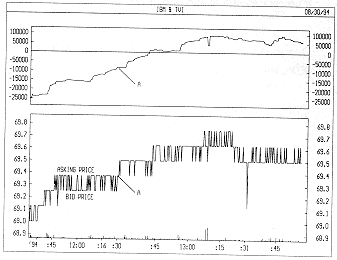
Technical Analysis from A to Z
by Steven B. Achelis
TRADE VOLUME INDEX
Overview
The Trade Volume Index ("TVI") shows whether a security is being accumulated (purchased) or distributed (sold).
The TVI is designed to be calculated using intraday "tick" price data. The TVI is based on the premise that trades taking place at higher "asking" prices are buy transactions and trades at lower "bid" prices are sell transactions.
Interpretation
The TVI is very similar to On Balance Volume. The OBV method works well with daily prices, but it doesn't work as well with intraday tick prices. Tick prices, especially stock prices, often display trades at the bid or ask price for extended periods without changing. This creates a flat support or resistance level in the chart. During these periods of unchanging prices, the TVI continues to accumulate this volume on either the buy or sell side, depending on the last price change.
The TVI helps identify whether a security is being accumulated or distributed. When the TVI is trending up, it shows that trades are taking place at the asking price as buyers accumulate the security. When the TVI is trending down, it shows that trades are taking place at the bid price as sellers distribute the security.
When prices create a flat resistance level and the TVI is rising, look for prices to breakout to the upside. When prices create a flat support level and the TVI is falling, look for prices to drop below the support level.
Example
The following chart shows IBM's tick prices and TVI.

During the 45 minutes leading up to the point labeled "A," prices were locked in a tight range between the bid price of 69 1/4 and the asking price of 69 3/8. During this same period, the TVI was trending upward which showed the prices were slowly being accumulated.
Calculation
The Trade Volume Index is calculated by adding each trade's volume to a cumulative total when the price moves up by a specified amount, and subtracting the trade's volume when the price moves down by a specified amount. The "specified" amount is called the "Minimum Tick Value."
To calculate the TVI you must first determine if prices are being accumulated or distributed:
![]()
![]()
![]()
![]()

Once you know the direction, you can then calculate the TVI:
![]()
![]()
Contents
- Preface
- Acknowledgments
- Terminology
- To Learn More
- Bibliography
- About the Author
- Technical Analysis
- Price Fields
- Charts
- Support & Resistance
- Trends
- Moving Averages
- Indicators
- Market Indicators
- Line Studies
- Periodicity
- The Time Element
- Conclusion
- Absolute Breadth Index
- Accumulation/Distribution
- Accumulation Swing Index
- Advance/Decline Line
- Advance/Decline Ratio
- Advancing-Declining Issues
- Advancing, Declining, Unchanged Volume
- Andrews' Pitchfork
- Arms Index
- Average True Range
- Bollinger Bands
- Breadth Thrust
- Bull/Bear Ratio
- Candlesticks - Japanese
- CANSLIM
- Chaikin Oscillator
- Commodity Channel Index
- Commodity Selection Index
- Correlation Analysis
- Cumulative Volume Index
- Cycles
- Demand Index
- Detrended Price Oscillator
- Directional Movement
- Dow Theory
- Ease of Movement
- Efficient Market Theory
- Elliott Wave Theory
- Envelopes (Trading Bands)
- Equivolume/Candlevolume
- Fibonacci Studies
- Four Percent Model
- Fourier Transform
- Fundamental Analysis
- Gann Angles
- Herrick Payoff Index
- Interest Rates
- Kagi
- Large Block Ratio
- Linear Regression Lines
- MACD
- Mass Index
- McClellan Oscillator
- McClellan Summation Index
- Median Price
- Member Short Ratio
- Momentum
- Money Flow Index
- Moving Averages
- Negative Volume Index
- New Highs-Lows Cumulative
- New Highs-New Lows
- New Highs/Lows Ratio
- Odd Lot Balance Index
- Odd Lot Purchases/Sales
- Odd Lot Short Ratio
- On Balance Volume
- Open Interest
- Open-10 TRIN
- Option Analysis
- Overbought/Oversold
- Parabolic SAR
- Patterns
- Percent Retracement
- Performance
- Point & Figure
- Positive Volume Index
- Price and Volume Trend
- Price Oscillator
- Price Rate-of-Change
- Public Short Ratio
- Puts/Calls Ratio
- Quadrant Lines
- Relative Strength, Comparative
- Relative Strength Index
- Renko
- Speed Resistance Lines
- Spreads
- Standard Deviation
- STIX
- Stochastic Oscillator
- Swing Index
- Three Line Break
- Time Series Forcast
- Tirone Levels
- Total Short Ratio
- Trade Volume Index
- Trendlines
- TRIX
- Typical Price
- Ultimate Oscillator
- Upside/Downside Ratio
- Upside/Downside Volume
- Vertical Horizonal Filter
- Volatility, Chaikin's
- Volume
- Volume Oscillator
- Volume Rate-of-Change
- Weighted Close
- Williams' Accumulation/Distribution
- Williams' %R
- Zig Zag